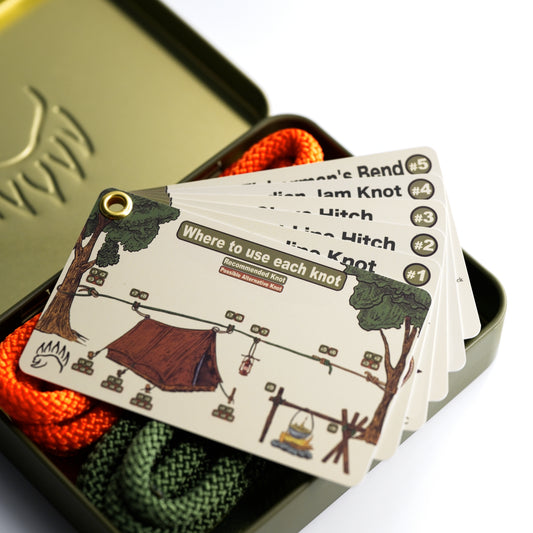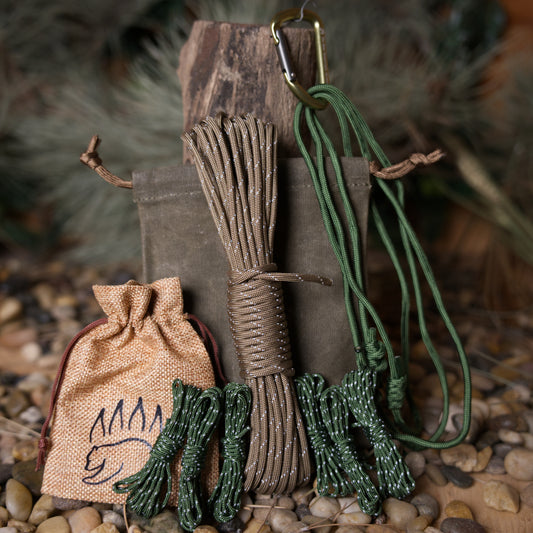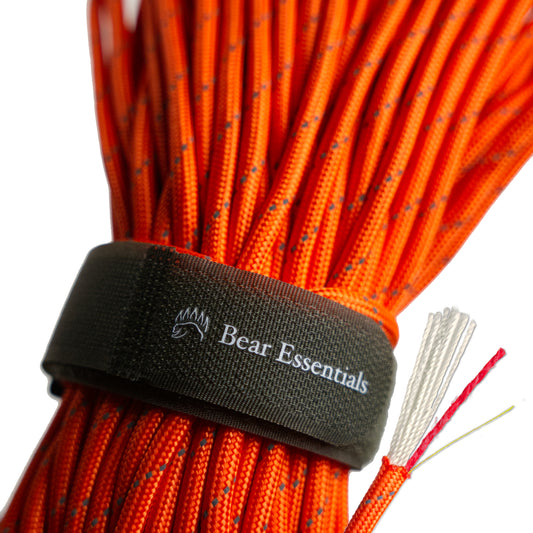How to Tie the Trucker’s Hitch - Inline Figure Eight Variation
Usage
The Trucker’s Hitch - Inline Figure Eight Variation is commonly used to tension ropes for securing loads, such as tarps or gear in camping setups. Compared to other tackle knots like the Poldo Tackle or the Trucker’s Hitch - Slipknot Variation, it aligns the pull directionally, making it ideal for straight-line tension. Learn how to tie the poldo tackle knot. Its advantage lies in creating a strong, adjustable system, but it can bind under extreme loads, requiring care to untie. It’s often used for taut shelters or hauling gear, though it needs sufficient rope length.
Why Learn the Trucker’s Hitch - Inline Figure Eight Variation?
- Directional pull: Aligns tension perfectly for straight-line setups.
- Strong loop: The figure-eight holds securely under moderate loads.
- Adjustable tension: Fine-tune tautness without retying the knot.
- Outdoor utility: Suits camping, bushcraft, or rescue hauling tasks.
- Simple components: Uses familiar knots for quick learning.
Common Uses
-
Scouts:
- Secures pioneering structures like bridges.
- Tensions ropes for camp setups.
-
Camping:
- Tightens guylines for stable tents.
- Secures tarps against wind.
-
Bushcraft:
- Hangs gear or food bags safely.
- Ties taut lines for shelter frames.
-
Search and Rescue:
- Hauls light equipment in rigging.
- Secures loads for transport.
ABOK Number
(Ashley Book of Knots)
Other Names
Category
|
How to Tie the Trucker’s Hitch - Inline Figure Eight Variation
- Tie an inline figure-eight loop mid-rope by creating a bight, twisting it twice, and threading the bight through the loop, then pulling tight.
- Pass the working end through an anchor point, such as a stake, tree, or ring.
- Thread the working end back through the figure-eight loop.
- Pull the working end to tighten the system, adjusting tension as needed.
- Lock the working end with two half hitches around the standing line.
Tips:
- Ensure the figure-eight loop is snug before tensioning to prevent slippage.
- Use a low-stretch rope for better control and less sag.
- Practice the inline figure-eight knot separately to tie it confidently.
Variations
Trucker’s Hitch - Alpine Butterfly Variation vs. Trucker’s Hitch - Inline Figure Eight Variation
- Pros: Doesn’t bind as tightly, making it easier to untie after heavy loads.
- Cons: Less directional, which can misalign pulls in straight-line setups.
Trucker’s Hitch - Double Dragon Variation vs. Trucker’s Hitch - Inline Figure Eight Variation
- Pros: Resists jamming and aligns well for in-line tensioning.
- Cons: More complex to tie, requiring additional steps.
Similar Knots
Trucker’s Hitch - Slipknot Variation vs. Trucker’s Hitch - Inline Figure Eight Variation
- Pros: Faster to tie for quick setups with minimal practice.
- Cons: Slipknot jams tightly, complicating release after heavy strain.
Poldo Tackle vs. Trucker’s Hitch - Inline Figure Eight Variation
- Pros: Allows dynamic loop adjustments for flexible tensioning.
- Cons: Requires more rope and is less intuitive for beginners.
History and Origins
The Trucker’s Hitch traces back to maritime and transport industries, where sailors and teamsters needed reliable knots to secure cargo. The Inline Figure Eight Variation likely emerged in modern outdoor contexts, adapting the figure-eight knot—referenced in The Ashley Book of Knots (#570)—for its strength and directional pull. Its use in scouting, camping, and rescue reflects its evolution into a practical solution for tensioning ropes in diverse scenarios. See this variation in action, figure-eight knot tutorial.
Security Level
The Trucker’s Hitch - Inline Figure Eight Variation holds securely under moderate loads when tied correctly, with the figure-eight loop providing a strong anchor point. For slick or polished surfaces, extra wraps in the loop can enhance grip. Adding a stopper knot such as the ashley stopper knot or the half hitch knot after the half hitches boosts reliability for critical applications, though it may bind tightly under extreme tension.
Downsides
- Binding risk: Can jam under very heavy loads, making untying tricky.
- Rope length: Needs extra rope for the loop and anchor setup.
FAQ
Is the Trucker’s Hitch - Inline Figure Eight Variation strong enough for securing tarps?
Yes, it’s reliable for tarps and shelters if tied properly, but check the anchor’s stability.
What rope works best for the Trucker’s Hitch - Inline Figure Eight Variation?
Nylon or polyester ropes with low stretch ensure stable tensioning.
How does the Trucker’s Hitch - Inline Figure Eight Variation differ from the Alpine Butterfly version?
It offers a more directional pull but may bind more than the non-jamming Alpine Butterfly.
Can the Trucker’s Hitch - Inline Figure Eight Variation be used for heavy hauling?
It suits moderate loads, but for heavy hauling, inspect the rope and anchor first.
Why use the Trucker’s Hitch - Inline Figure Eight Variation instead of a bungee cord?
It’s adjustable and reusable without hardware, ideal for remote camping or bushcraft.
Important Notes on Safety
- Common failure points include a loose figure-eight loop or an unstable anchor. Always confirm the loop is tight and the anchor is solid before applying tension.
- Inspect the rope for fraying or wear before use.
- Secure with at least two half hitches to lock tension.
- Practice tying in low-risk settings to build confidence.









